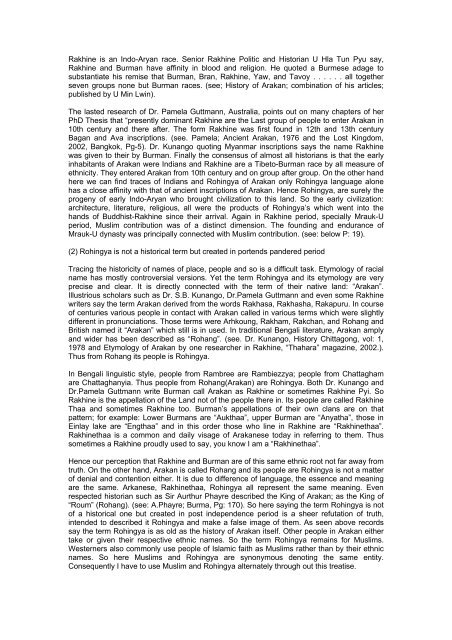Rohingya History: Myth and Reality - Rohingya Society In Malaysia
Rohingya History: Myth and Reality - Rohingya Society In Malaysia
Rohingya History: Myth and Reality - Rohingya Society In Malaysia
You also want an ePaper? Increase the reach of your titles
YUMPU automatically turns print PDFs into web optimized ePapers that Google loves.
Rakhine is an <strong>In</strong>do-Aryan race. Senior Rakhine Politic <strong>and</strong> Historian U Hla Tun Pyu say,<br />
Rakhine <strong>and</strong> Burman have affinity in blood <strong>and</strong> religion. He quoted a Burmese adage to<br />
substantiate his remise that Burman, Bran, Rakhine, Yaw, <strong>and</strong> Tavoy . . . . . . all together<br />
seven groups none but Burman races. (see; <strong>History</strong> of Arakan; combination of his articles;<br />
published by U Min Lwin).<br />
The lasted research of Dr. Pamela Guttmann, Australia, points out on many chapters of her<br />
PhD Thesis that “presently dominant Rakhine are the Last group of people to enter Arakan in<br />
10th century <strong>and</strong> there after. The form Rakhine was first found in 12th <strong>and</strong> 13th century<br />
Bagan <strong>and</strong> Ava inscriptions. (see. Pamela; Ancient Arakan, 1976 <strong>and</strong> the Lost Kingdom,<br />
2002, Bangkok, Pg-5). Dr. Kunango quoting Myanmar inscriptions says the name Rakhine<br />
was given to their by Burman. Finally the consensus of almost all historians is that the early<br />
inhabitants of Arakan were <strong>In</strong>dians <strong>and</strong> Rakhine are a Tibeto-Burman race by all measure of<br />
ethnicity. They entered Arakan from 10th century <strong>and</strong> on group after group. On the other h<strong>and</strong><br />
here we can find traces of <strong>In</strong>dians <strong>and</strong> <strong>Rohingya</strong> of Arakan only <strong>Rohingya</strong> language alone<br />
has a close affinity with that of ancient inscriptions of Arakan. Hence <strong>Rohingya</strong>, are surely the<br />
progeny of early <strong>In</strong>do-Aryan who brought civilization to this l<strong>and</strong>. So the early civilization:<br />
architecture, literature, religious, all were the products of <strong>Rohingya</strong>’s which went into the<br />
h<strong>and</strong>s of Buddhist-Rakhine since their arrival. Again in Rakhine period, specially Mrauk-U<br />
period, Muslim contribution was of a distinct dimension. The founding <strong>and</strong> endurance of<br />
Mrauk-U dynasty was principally connected with Muslim contribution. (see: below P: 19).<br />
(2) <strong>Rohingya</strong> is not a historical term but created in portends p<strong>and</strong>ered period<br />
Tracing the historicity of names of place, people <strong>and</strong> so is a difficult task. Etymology of racial<br />
name has mostly controversial versions. Yet the term <strong>Rohingya</strong> <strong>and</strong> its etymology are very<br />
precise <strong>and</strong> clear. It is directly connected with the term of their native l<strong>and</strong>: “Arakan”.<br />
Illustrious scholars such as Dr. S.B. Kunango, Dr.Pamela Guttmann <strong>and</strong> even some Rakhine<br />
writers say the term Arakan derived from the words Rakhasa, Rakhasha, Rakapuru. <strong>In</strong> course<br />
of centuries various people in contact with Arakan called in various terms which were slightly<br />
different in pronunciations. Those terms were Arhkoung, Rakham, Rakchan, <strong>and</strong> Rohang <strong>and</strong><br />
British named it “Arakan” which still is in used. <strong>In</strong> traditional Bengali literature, Arakan amply<br />
<strong>and</strong> wider has been described as “Rohang”. (see. Dr. Kunango, <strong>History</strong> Chittagong, vol: 1,<br />
1978 <strong>and</strong> Etymology of Arakan by one researcher in Rakhine, “Thahara” magazine, 2002.).<br />
Thus from Rohang its people is <strong>Rohingya</strong>.<br />
<strong>In</strong> Bengali linguistic style, people from Rambree are Rambiezzya; people from Chattagham<br />
are Chattaghanyia. Thus people from Rohang(Arakan) are <strong>Rohingya</strong>. Both Dr. Kunango <strong>and</strong><br />
Dr.Pamela Guttmann write Burman call Arakan as Rakhine or sometimes Rakhine Pyi. So<br />
Rakhine is the appellation of the L<strong>and</strong> not of the people there in. Its people are called Rakhine<br />
Thaa <strong>and</strong> sometimes Rakhine too. Burman’s appellations of their own clans are on that<br />
pattern; for example: Lower Burmans are “Aukthaa”, upper Burman are “Anyatha”, those in<br />
Einlay lake are “Engthaa” <strong>and</strong> in this order those who line in Rakhine are “Rakhinethaa”.<br />
Rakhinethaa is a common <strong>and</strong> daily visage of Arakanese today in referring to them. Thus<br />
sometimes a Rakhine proudly used to say, you know I am a “Rakhinethaa”.<br />
Hence our perception that Rakhine <strong>and</strong> Burman are of this same ethnic root not far away from<br />
truth. On the other h<strong>and</strong>, Arakan is called Rohang <strong>and</strong> its people are <strong>Rohingya</strong> is not a matter<br />
of denial <strong>and</strong> contention either. It is due to difference of language, the essence <strong>and</strong> meaning<br />
are the same. Arkanese, Rakhinethaa, <strong>Rohingya</strong> all represent the same meaning. Even<br />
respected historian such as Sir Aurthur Phayre described the King of Arakan; as the King of<br />
“Roum” (Rohang). (see: A.Phayre; Burma, Pg: 170). So here saying the term <strong>Rohingya</strong> is not<br />
of a historical one but created in post independence period is a sheer refutation of truth,<br />
intended to described it <strong>Rohingya</strong> <strong>and</strong> make a false image of them. As seen above records<br />
say the term <strong>Rohingya</strong> is as old as the history of Arakan itself. Other people in Arakan either<br />
take or given their respective ethnic names. So the term <strong>Rohingya</strong> remains for Muslims.<br />
Westerners also commonly use people of Islamic faith as Muslims rather than by their ethnic<br />
names. So here Muslims <strong>and</strong> <strong>Rohingya</strong> are synonymous denoting the same entity.<br />
Consequently I have to use Muslim <strong>and</strong> <strong>Rohingya</strong> alternately through out this treatise.


